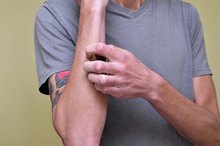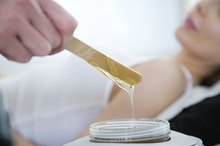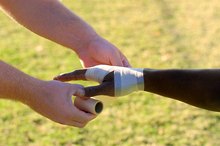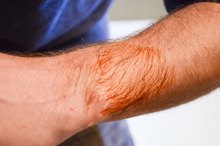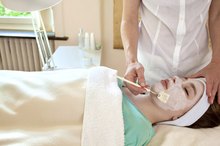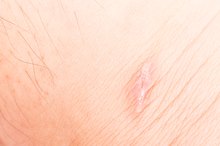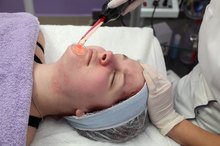What does fact checked mean?
At Healthfully, we strive to deliver objective content that is accurate and up-to-date. Our team periodically reviews articles in order to ensure content quality. The sources cited below consist of evidence from peer-reviewed journals, prominent medical organizations, academic associations, and government data.
The information contained on this site is for informational purposes only, and should not be used as a substitute for the advice of a professional health care provider. Please check with the appropriate physician regarding health questions and concerns. Although we strive to deliver accurate and up-to-date information, no guarantee to that effect is made.
How to Fade Scars From Chemical Burns
Chemical burns can occur in a number of different ways. While some may associate chemical burns with scalding, scarring acid, you can develop a chemical burn scar in your daily life fairly easily. Some topical skin medications and treatments, particularly those obtained through a prescription, can create light burns on the skin that leave scarring. Even treatments like chemical peels, which are intended to eliminate scars residing on the top of your skin, can leave a burn scar if applied improperly. Fortunately, most burn scars do not extend deep into the skin and can be easily faded through several different methods.
Use a chemical peel to eliminate the burn scar. Even if you received the scar from a chemical peel, you can still fade the scar through properly applying a chemical peel, which usually consists of glycolic acid, onto the skin. Some people may be hesitant to use this method if a chemical peel caused the initial burn scar, but in almost all cases, chemical peel burns are the result of a non-professional application.
Visit a doctor or dermatologist to receive a chemical peel safely and have the top-layers of your skin removed so you can burn off scar tissue and encourage the growth of healthy skin cells to replace it.
How to Get Rid of Scratch Scars
Learn More
Use a dermabrasion treatment to remove the top of the scar, fading its appearance. Dermabrasion works in a similar way to a chemical peel, although there is a longer recovery period of about one week, according to the American Academy of Dermatology 2. This treatment uses a hard object to skim off the top of your skin, shedding scar tissue along with it.
Receive a scar-revision treatment from a doctor or dermatologist. Scar revision can work in several ways. One method is using high-energy light to remove or reshape damaged skin. This has a one-week recovery period, though the skin may retain a pink shade for several months, according to the American Academy of Dermatology 2. Yellow-light treatments can also reduce redness or raised surfaces that develop from a chemical burn.
Multiple scar-revision treatments may be needed to reach its full effect, and this can be a costly option.
How to Get Rid of Stitch Scars on the Face
Learn More
Receive an invasive surgery to cut out the scar tissue and sew up your skin. This is the last option for many people, since surgery often leaves a scar of its own, but for deep burns, this can be an effective, if costly, approach.
Related Articles
References
- Mayo Clinic: Burns Lifestyle and Home Remedies
- American Academy of Dermatology: What is a Scar
- University of Maryland Medical Center: Burns
- Shin TM, Bordeaux JS. The role of massage in scar management: a literature review. Dermatol Surg. 2012;38(3):414-23. doi:10.1111/j.1524-4725.2011.02201.x
- Ault P, Plaza A, Paratz J. Scar massage for hypertrophic burns scarring-A systematic review. Burns. 2018;44(1):24-38. doi:10.1016/j.burns.2017.05.006
- Cheatham SW, Lee M, Cain M, Baker R. The efficacy of instrument assisted soft tissue mobilization: a systematic review. J Can Chiropr Assoc. 2016;60(3):200-211.
- Kohata K, Itoh S, Horiuchi N, Yoshioka T, Yamashita K. Influences of osteoarthritis and osteoporosis on the electrical properties of human bones as in vivo electrets produced due to Wolff's law. Biomed Mater Eng. 2017;28(1):65-74. doi:10.3233/BME-171657
- Cheatham, S. Et al. The Efficacy of Instrument Assisted Soft Tissue Mobilization: A Systematic Review. J Can. Chiro, Assoc. 2016 Sep; 60(3): 200-11.
- Kim J, Sung DJ, Lee J. Therapeutic effectiveness of instrument-assisted soft tissue mobilization for soft tissue injury: mechanisms and practical application.Journal of Exercise Rehabilitation. 2017;13(1):12-22. doi:10.12965/jer.1732824.412.
- Kisner, C., & Colby, L. A. Therapeutic exercise: Foundations and techniques. (3 ed.). Philadelphia: FA Davis.
- Shin TM, Bordeaux JS. The Role of Massage in Scar Management: A Literature Review.Dermatologic Surgery. 2012;38(3):414-423. doi:10.1111/j.1524-4725.2011.02201.x.
Writer Bio
Jonathan Croswell has spent more than five years writing and editing for a number of newspapers and online publications, including the "Omaha World-Herald" and "New York Newsday." Croswell received a Bachelor of Arts degree in English from the University of Nebraska and is currently pursuing a Master's of Health and Exercise Science at Portland State University.
